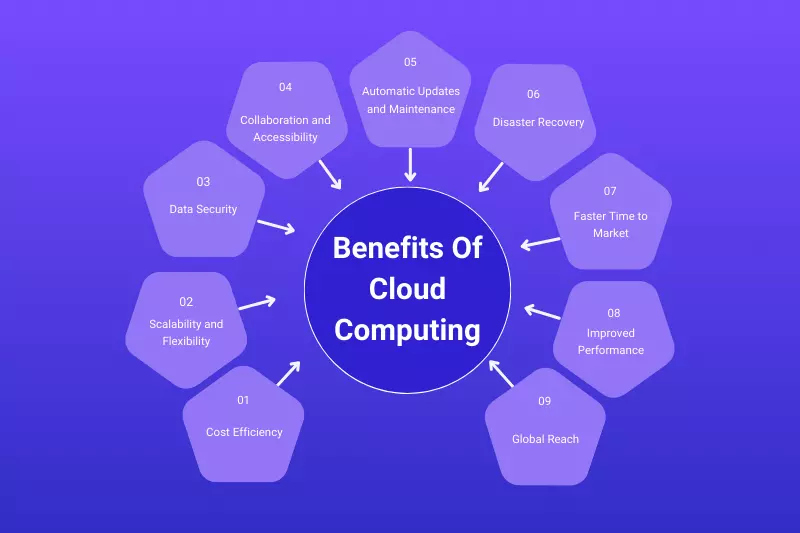In 2025, cloud computing has become the backbone of digital transformation. From startups to multinational corporations, organizations rely on cloud platforms to streamline operations, scale efficiently, and drive innovation. With advanced technologies such as AI, machine learning, and edge computing integrated into cloud services, the benefits are greater than ever.
This article explores the key benefits of cloud computing in 2025 and why adopting a cloud-first strategy is vital for business success.
☁️ What Is Cloud Computing?
Cloud computing refers to the delivery of computing services—including storage, servers, databases, networking, software, and analytics—over the internet (“the cloud”). Instead of owning and maintaining physical data centers or servers, businesses can access technology resources on-demand from cloud providers.
Popular cloud platforms in 2025 include:
- Amazon Web Services (AWS)
- Microsoft Azure
- Google Cloud Platform (GCP)
- IBM Cloud
- Oracle Cloud Infrastructure (OCI)
💡 Key Benefits of Cloud Computing in 2025
1. Cost Efficiency
- Eliminates capital expenses for hardware and infrastructure.
- Pay-as-you-go pricing models reduce financial risk.
- Resources can be scaled up or down based on demand.
2. Scalability and Flexibility
- Instantly scale computing resources to meet workload needs.
- Handle traffic spikes, growing datasets, and seasonal demand with ease.
- Perfect for businesses with dynamic or unpredictable workloads.

3. Remote Accessibility
- Access data and applications from anywhere, on any device.
- Supports remote work, hybrid teams, and global collaboration.
- Ensures business continuity in emergencies or disasters.
4. Enhanced Security
- Cloud providers offer advanced security features such as:
- End-to-end encryption
- Multi-factor authentication (MFA)
- Regular security patches and updates
- Compliance with global standards like GDPR, HIPAA, and ISO 27001.
5. Disaster Recovery and Backup
- Automatic data backups and replication across multiple locations.
- Quick recovery from outages, cyberattacks, or hardware failures.
- Improves business resilience and uptime.
6. Improved Collaboration
- Real-time collaboration through shared documents, tools, and communication platforms.
- Cloud-based project management and productivity suites (e.g., Microsoft 365, Google Workspace).
- Version control and activity tracking keep teams aligned.
7. Automatic Updates and Maintenance
- Cloud providers manage infrastructure, software updates, and bug fixes.
- Frees up internal IT teams to focus on strategic tasks.
- Ensures access to the latest features and performance improvements.
8. Environmental Sustainability
- Shared cloud infrastructure uses energy more efficiently than traditional data centers.
- Providers invest in green energy and carbon neutrality initiatives.
- Supports organizations’ environmental, social, and governance (ESG) goals.
9. Integration with Emerging Technologies
- Seamlessly integrates with AI, machine learning, IoT, and big data analytics.
- Accelerates innovation and digital transformation.
- Enables predictive insights, automation, and smarter decision-making.
10. Business Agility
- Launch new services and applications faster.
- Respond quickly to market changes or customer needs.
- Enhance competitive advantage through rapid experimentation and deployment.
🔧 Cloud Deployment Models
Businesses can choose from different deployment models based on their needs:
- Public Cloud: Services shared among multiple organizations (e.g., AWS, Azure).
- Private Cloud: Dedicated infrastructure for a single organization.
- Hybrid Cloud: Combines public and private cloud for greater flexibility.
- Multi-Cloud: Uses services from multiple cloud providers to avoid vendor lock-in.
🛡️ Addressing Common Cloud Concerns
While the benefits are substantial, some concerns remain:
- Data privacy: Must ensure proper governance and access controls.
- Downtime risk: Choose reputable providers with robust SLAs.
- Cost management: Monitor usage to avoid unexpected charges.
Most of these challenges are now manageable with advanced cloud monitoring, automation, and strategic planning.
🔮 The Future of Cloud Computing
Looking ahead, cloud computing will continue to evolve with:
- Edge computing for real-time processing close to the data source.
- Serverless architecture to reduce operational complexity.
- AI-driven cloud management for intelligent resource optimization.
- Quantum cloud services to handle complex computations.
✅ Conclusion
In 2025, cloud computing is no longer optional—it’s a competitive necessity. From cost savings and scalability to innovation and resilience, the benefits of cloud computing empower businesses to operate smarter, faster, and more securely.
Embracing the cloud isn’t just about adopting new technology—it’s about unlocking new possibilities.



